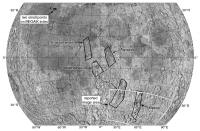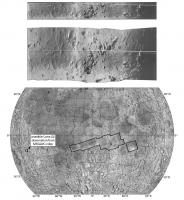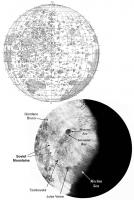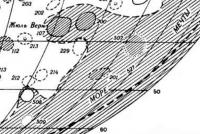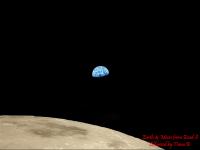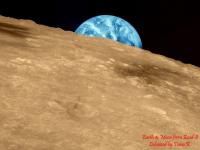Printable Version of Topic
Click here to view this topic in its original format
Unmanned Spaceflight.com _ Lunar Exploration _ Soviet Lunar Images
Posted by: Phil Stooke Jun 28 2005, 04:49 PM
Here's another very interesting and little known topic, so this is a chance to ask or to post about it.
I am looking for information on the Soviet Union's lunar missions. Actually I have lots already, but you can always use a bit more.
Specifically, consider this question: what areas were photographed by the Soviet lunar orbiters, Lunas 12, 19 and 22? First I must say that these were NOT systematic mapping missions, they were tests of experimental imaging systems, and the SU never undertook any systematic mapping of the Moon. So coverage is limited.
I have searched high and low for images from these missions, helped especially by the extremely talented and knowledgeable Don Mitchell. For this post I'm going to stick to Luna 19, coming back to the others later. Between us, Don and I have located five Luna 19 images, often of very poor quality (photocopies of prints from magazines, microfilm of russian newspapers, etc.) I reprojected them into approximate mapping geometry and then searched for their locations on the Moon. Result, the first ever (AFAIK) index map of Luna 19 coverage. When I was in Moscow I asked for this but got nowhere, and I'm not sure they ever did it, or certainly didn't publish it. The area often reported as the focus of Luna 19 images refers in fact only to one orbit.
So, here's the index map;
and if anybody can track down any OTHER Luna 19 images I would be VERY grateful for the information.
Phil
Posted by: tedstryk Jun 29 2005, 02:42 AM
What I have is very limited -
http://pages.preferred.com/%7Etedstryk/luna19.html
The best I know of is on Don Mitchell's site, but I'm sure you have already seen it...I will do a dig through my archives to see if I can caugh anything else up.
Edit: I came up empty. I did find some Luna 12 and 22 stuff in my collection. Here is the Luna 12 image I have:
Posted by: Phil Stooke Jun 29 2005, 12:38 PM
Thanks, Ted - a nice pair of images (they are joined together here, but I believe they are not actually contiguous on the surface). I had seen these before, but these are very good copies of them.
Luna 12 took images on film, developed them and scanned the negatives, just like Luna 3 and Zond 3 before it. (and the NASA Lunar Orbiters). In fact the first purely electronic imaging system flown in lunar orbit may have been Luna 19, though I admit I am not certain of that.
Luna 12 took about 20 images, of which I have seen four. They cover a narrow strip from just south of Aristarchus (where these images of Ted's are) through crater Eratosthenes into northern Mare Tranquillitatis. All of the eastern half of the strip would be under very high sun, not very good images, and I've never seen any of those.
Phil
Posted by: tedstryk Jun 30 2005, 04:06 PM
Well, the Luna landers had fully electronic imaging systems. But I think it is the first Soviet orbiter to have one. Here are two rectified Luna 22 shots.
http://img158.imageshack.us/my.php?image=luna2213nr.jpg
http://img158.imageshack.us/my.php?image=luna2226km.jpg
Posted by: Phil Stooke Jun 30 2005, 07:34 PM
Nice images, Ted! Thanks.
Below I have attached the Luna 22 coverage map. This map also has a pair of images above it: one original Luna 22 image and the same image rectified (like Ted's).
Luna 19 and Luna 22 both imaged with a scanner which scanned from horizon to horizon, and then potentially from terminator to terminator. The actual length of the imaging tracks is unknown. For Luna 19, for instance, we have only 5 small fragments... are they all that were made, or just bits of long panoramic images? For Luna 22 (see my map) we have longer images. But the full extent is still not known.
Both of Ted's images fall in areas I have already mapped (alas!). The first crater is Ptolemaeus, the second Gutenberg.
In Moscow, I was shown the negatives from Luna 22, kept in a safe in the Department of Lunar and Planetary Research at Sternberg State Astronomical Institute. But I could not copy them, or learn anything useful about coverage. My material came from a set at Flagstaff. Don Mitchell also found prints of a few images in magazines or books. But if anyone finds a new one let me know! Posterity will thank you.
Phil
Posted by: tedstryk Jun 30 2005, 09:44 PM
Great map. I am investigating possible leads for more imagery, and have our ILL sleuths at work on it!
Posted by: JTN Dec 27 2005, 11:20 PM
(This seems like a reasonable topic to revive for this question...)
Soviet-themed names were apparently assigned to the apparent features on the lunar farside based on Luna 3 images, as depicted on http://antwrp.gsfc.nasa.gov/apod/ap001021.html. According to the APOD text, the features named include "the Sea of Moscow, the Soviet Mountains, the Bay of Astronauts, and the Sea of Dreams". (I've only checked the last one with a machine translator.) Perhaps other features are named too?
The Sea of Moscow name is still widely used (although the Latin appears different - Mare Moscoviense vs old Mare Moscovrae), but the others appear to be long gone.
I'm curious about these old names. Is there a better map showing their locations? Are there more of them? Did they die out because the features turned out not to be real, through politics, or for some other reason?
(FWIW, here is a http://groups.google.co.uk/groups?&selm=ATp*0hTKo%40news.chiark.greenend.org.uk I made some years ago with similar musings, mainly about Mare Desiderii.)
Posted by: Phil Stooke Dec 29 2005, 08:31 PM
Good question, JTN. It is one I have looked at closely during my work on my forthcoming atlas.
The spacecraft we call Luna 1 was not called that when it was launched. It was just called 'The Cosmic Rocket', and nicknamed Mechta - 'dream' - reflecting in a common Russian style the romantic notion that space flight, or flights to the Moon, were an ancient dream of humanity, only now being fulfilled. When the first maps of the far side were drawn up in the Soviet Union, a dark smudge on the limb near the central far side was called 'More Mechta' - the Sea of Mechta, a commemoration of the flight of Luna 1. In the west it was often translated 'Sea of Dreams' - which omits the reference to Luna 1 - but the name is singular, not plural. Sea of Dreams is a mistake, and latin translations of 'Sea of Dreams' only make it worse. The designations Luna 1, 2, 3 and so on were only applied retrospectively after Luna 3.
I'll post an image later.
Phil
Posted by: Phil Stooke Dec 29 2005, 08:39 PM
Perhaps " More Mecht' " would be a better transliteration of the name.
Here are two images:
Phil
Posted by: Phil Stooke Dec 29 2005, 08:44 PM
The Soviet Mountains turned out to be a ray system. Astronaut Bay (NOTE the term Cosmonaut was not being used in 1959!) is poorly defined and was abandoned. Mechta Sea didn't clearly relate to a true mare and was dropped. But Giordano Bruno, Tsiolkovskii, Jules Verne and Mare Moscoviense continue to be used. V.V. Shevchenko of Sternberg and a colleague have argued that Mechta Sea is the first glimpse of the low albedo floor of South Pole - Aitken basin, and I agree with this interpretation.
Phil
Posted by: BruceMoomaw Dec 30 2005, 02:25 AM
Two more footnotes:
(1) The Soviet naming system for its first few years of launches bore no resemblance whatsoever to the names attached to the missions by the US press for convenience. Not only were the first three Lunas not called that at the time, but Venera 1 was also really called one of the "Cosmic Rockets". And "Sputniks 4 through 10", the unmanned Vostok tests and the two orbital stages for the 1961 Veneras (one of which failed to restart), were none of them called Sputnik -- they were given some other awkward names that I've forgotten.
Then, after sensibly calling their next two deep-space probes Mars 1 and Luna 4, the Soviets -- on Khrushchev's insistence -- gave their 1964 Venus probe the noncommittal name of Zond ("Probe") 1, and didn't admit for months that it was even aimed at Venus, so that they had some alibi (very transparent) if it failed, as it did. They even called their 1964 Mars probe Zond 2, despite the fact that they admitted instantly that it was aimed at Mars (and also that it had serious power problems) -- but Khruschchev had been kicked out just the month before, and after that the Brezhnev government at least stopped that nonsensical game of nomenclatural peekaboo.
(2) In Arthur C. Clarke's 1962 story "Maelstrom II", the Soviet Mountains -- in which everyone still believed at that time -- play an important plot role.
Posted by: BruceMoomaw Dec 30 2005, 02:32 AM
Additional note: that Mechta ("Daydream") name for the first Luna probe was certainly Korelev's idea. He had a taste for inspirational names with no ideological element whatsoever; thus also Sputnik ("Traveling Friend"), and Vostok ("East", which has long been a Russian slang term for "Dawn", as in "dawn of a new era for mankind". I shudder to think what names the Soviets might have given their probes if the Chief Designer had had less of a personal disdain for Communism (thanks to his near-death experience under Stalin).
Posted by: nprev Dec 30 2005, 09:07 AM
The mind reels..."Glorious Smolensk Tractor Works Collective Effort 1" might well have been the first succesful Venera!
Posted by: Bob Shaw Dec 31 2005, 12:47 AM
Er... ...'Minuteman'. 'Columbia'. I could go on...
When, centuries from now, the victors (whoever she and her sisters may be) write the history of space colonisation, I hope the nomenclature of our own cultural imperialism stands up as well under their gaze as Korolev's charming and life-affirming names for his glorious efforts!
Bob Shaw
Posted by: BruceMoomaw Dec 31 2005, 02:54 AM
Actually, the US hasn't been that bad in that regard -- almost the only examples of nationalistic crowing I can find are the names given by three of the Mercury 7 astronauts to their capsules (Shepard, Grissom and Cooper), and the names of the two Apollo 11 ships -- and I think the latter can be excused; after all, it DID just take note of the fact that We Got There First.
Well, there was Reagan's insistence on naming the Space Station "Freedom", as a way of sticking his thumb in the Kremlin's eye -- and of course after it turned into a collaboration with Russia it got the memorably inspirational new name of "Alpha". (It might have been wiser to name it "Omega", since it seems likely to finish off the US manned space program once and for all.) As for "Minuteman": well, that was a WEAPON, and calling it that was just the equivalent of all those Soviet May Day parades. (One New Yorker cartoon showed the Kremlin recognizing the advent of detente by adding giant cartoon-character balloons to the parade.)
Posted by: David Dec 31 2005, 04:09 AM
Although the name Columbia certainly refers to America (symbolized by 'the goddess Columbia', a woman dressed in star-spangles), the direct reference is probably to the Columbia of Robert Gray, which explored the Pacific Northwest in the 1790s (and after which the Columbia river, and, indirectly, British Columbia are named).
The other shuttles except for Atlantis are also named after ships of exploration; the HMS Discovery and HMS Endeavour were among the ships of Captain James Cook's expeditions; the HMS Challenger was a British marine research vessel of the 1870s. The Atlantis is named after a Woods Hole Oceanographic Institute research ship of the early 20th century.
The program names "Mercury, Gemini, Apollo" are more or less random mythological or astronomical names (and except for Gemini, not very well chosen).
The call signs for the Apollo 9 CSM and LEM (Gumdrop, Spider) were references to the shapes of the craft, one conical, one many-legged.
The call signs for the Apollo 10 CSM and LEM (Charlie Brown, Snoopy) were popular culture references to Charles M. Schulz's comic strip Peanuts.
The Apollo 11 Columbia CSM presumably has the same origin for its name as the Shuttle Columbia. The LEM Eagle is a reference to the American national symbol, and so intended as 'patriotic'.
"Yankee Clipper" (the Apollo 12 CSM) perhaps refers to the PanAm flying boat, if not to actual New England clipper ships. The "Intrepid" LEM probably takes its name from the WWII carrier, and so is a more martial name than the others.
The Apollo 13 CSM "Odyssey" may owe its name to the Kubrick/Clarke movie. The "Aquarius" LEM seems to have been another random astronomical reference, though it probably reminded people of the "Age of Aquarius".
The "Kitty Hawk" CSM of Apollo 14 of course suggests the place where the Wrights flew their first "Flyer", but was also the name of an important aircraft carrier. The LEM "Antares" is apparently another random astronomical reference.
The Apollo 15 CSM "Endeavour" has the same referent as the shuttle. The LEM "Falcon" is named after the Air Force Academy mascot.
The Apollo 16 CSM "Casper" takes its name from the "friendly ghost" of the comic books. There may be some NASA in-joke here I don't get. The LEM "Orion" is another random astronomical reference.
The Apollo 17 CSM "America" of course refers to America, but also the aircraft carrier America and (perhaps) the famous racing yacht. The LEM "Challenger" has the same referent as the Shuttle.
This gives us the following classes of names used by American manned space vessels:
Ships of Exploration: Columbia, Endeavour, Challenger, Discovery, Atlantis
Ships of War: Intrepid, Kitty Hawk, America
Other patriotic/martial: Eagle, Falcon, perhaps Yankee Clipper
Astronomy: Aquarius, Antares, Orion
Pop Culture: Charlie Brown, Snoopy, Odyssey, Casper
Other: Gumdrop, Spider
I don't recall all the names given to unmanned American probes. They seem mostly to have been intended to suggest themes of travel: Mariner, Pioneer, Viking, Magellan; although of late they have become descriptive and (if I may say so) pedestrian, tending towards "alphabet soup": MER, MRO, MGS, etc. There are also the probes named after early scientists (Galileo, Cassini). The "inspirational" names Spirit and Opportunity are perfectly serviceable but jejune (at least in America, where they are stock words in political speeches).
[Edited: Updated with information from elsewhere in this thread. Thanks to mcaplinger and dvandorn.]
Posted by: dvandorn Dec 31 2005, 04:24 AM
I dunno, Bruce, there are several other Apollo-era nicknames that are unabashedly patriotic -- Kitty Hawk (Apollo 14 CSM), Yankee Clipper (Apollo 12 CSM), and of course America herself (Apollo 17 CSM). One might argue that Falcon (Apollo 15 LM) was a patriotic name, as Dave Scott named it after the mascot of the U.S. Air Force Academy.
-the other Doug
Posted by: mcaplinger Dec 31 2005, 04:59 AM
From http://www1.jsc.nasa.gov/jscfeatures/articles/000000415.html
"Atlantis was named after the primary research vessel for the Woods Hole Oceanographic Institute in Massachusetts from 1930 to 1966. The two-masted, 460-ton ketch was the first U.S. vessel to be used for oceanographic research."
I have heard, though I can't prove this, that one of the people on the naming committee was associated with WHOI and got this name selected. I think it's fair to say that it doesn't have as much historical significance as a lot of others they could have picked.
Posted by: edstrick Dec 31 2005, 12:22 PM
We should also remember the one and only Gemini spacecraft to have a name, even if it (I think) wasn't painted on anywhere: "Molly Brown"... the Unsinkable Gemini 3, so named by Grissom after his Mercury flight debacle.
The "Suits" were more than not impressed. They banned the use of flight names till Apollo 9 needed call signs so Houston could talk to one or the other spacecraft.
Posted by: Bob Shaw Dec 31 2005, 12:32 PM
'Columbiad' = 'Columbia'?
Bob Shaw
Posted by: BruceMoomaw Dec 31 2005, 11:33 PM
Frank Borman wanted to name Apollo 8 "Columbiad", in honor of Jules Verne's circumlunar ship, but NASA nixed it. (The Gemini 4 crew wanted to name theirs "The American Eagle" -- now, THERE'S chauvinism, not to mention lack of imagination -- while the Gemini 5 crew wanted to name theirs "Lady Bird" (Conrad's idea, no doubt).
Posted by: dvandorn Dec 31 2005, 11:43 PM
Mike Collins comments on the process by which the Apollo 11 CSM was named "Columbia." It seems that Columbia and Eagle, as a set, was suggested by someone *not* on the crew fairly early on in the training cycle. Collins liked the idea of Columbia for several reasons -- for one, it was *almost* the name given to the country (there was some lively debate back in 1776 between naming the country simply "America," "The United States of America," "The United States of Columbia," or simply "Columbia"). There was also the Jules Verne reference, though Collins considered that minor (after all, in Verne's book, the spacecraft wasn't named Columbiad, the *gun* was).
What Collins liked the most about the name was the fact that the song lyric "Columbia, the Gem of the Ocean" kept popping into his mind -- and since their CM was supposed to end its operational life as a ship in the ocean (if a poor one), he felt the name boded well for a successful (and survivable) mission.
-the other Doug
Posted by: JTN Jan 2 2006, 01:34 AM
Thanks, Phil, and Bruce -- this has been bugging me for years!
So, a bit like the "Muses Sea"? And "Mare Desiderii" is doubly unreal. (I've often thought it would be a good setting for a work of fiction, like St Matthew's College, Cambridge, and this info just reinforces that.)
Posted by: ljk4-1 Jan 3 2006, 03:13 AM
Anyone wanting to know the origin of most NASA spacecraft names (at least through 1976) can find them in the online document Origins of NASA Names here:
http://history.nasa.gov/SP-4402/SP-4402.htm
Interesting tidbits: Ranger came from JPL planning director C. D. Cummings in 1960 after he noticed the name Ranger on his pick-up truck during a camping trip.
Two early ideas for names of what would become the Explorer series of satellites were Project Deal and Top Kick. Oy.
Posted by: BruceMoomaw Jan 3 2006, 07:37 PM
Well, the first name for a proposed US artificial satellite project was MOUSE.
Posted by: Bob Shaw Jan 3 2006, 08:48 PM
M inimum
O rbit
U nmanned
S atellite
E xperiment
Bob Shaw
Posted by: dvandorn Jan 3 2006, 11:34 PM
Yes -- and the U.S. Air Force's man-in-space program (which was canceled when NASA was given complete control over American manned spaceflight) was called MISS -- Man In Space Soonest.
The MISS capsule designs looked an *awful* lot like what ended up flying as Mercury...
-the other Doug
Posted by: ljk4-1 Jan 23 2006, 03:42 PM
Dust cloud produced by Luna 5 impacting the lunar surface:
http://ntrs.nasa.gov/archive/nasa/casi.ntrs.nasa.gov/19790073878_1979073878.pdf
Posted by: Phil Stooke Jan 23 2006, 04:45 PM
I can provide more information on the Luna 5 event.
A series of low quality images from the East German observations was published in New Scientist shortly after the event - I don't have the actual reference for that, maybe someone can track it down.
This dust cloud was located near Pitatus crater south of Mare Nubium. Luna 5 itself crashed near Lansberg crater, close to the equator. The Pitatus event was caused by the upper stage which propelled Luna 5 to the moon.
Controversy has always surrounded observations like this. Luna 2 and Luna 7 impacts may also have been observed (see Sky & Telescope just after Luna 2 for a description of that, but again I don't have a reference in front of me). No US impacts were ever observed despite repeated efforts, so US sources tended to discount these reports (though the Luna 7 report is from a US source, not the Soviets). Only Hiten, the Japanese mission, is unequivocally known to have been observed from Earth.
Phil
Posted by: ljk4-1 Jan 26 2006, 05:20 AM
Bleeps from Luna 3?
http://www.svengrahn.pp.se/radioind/Luna3beeps/Luna3beeps.html
Luna 3 - the first view of the Moon's far side
http://www.svengrahn.pp.se/trackind/luna3/Luna3story.html
Posted by: Phil Stooke Jan 26 2006, 05:35 PM
This story mentions Jodrell Bank radio telescope in the UK picking up some Luna 3 transmissions. If you Google 'Luna 3' you find some websites which mangle this story, saying that JB released the Luna 3 images in a distorted format. That is mixing up the Luna 3 story with Luna 9, where they did indeed jump the gun with a controversial release. It makes no sense to imagine Luna 3 images released in distorted form, as the non-circular disk would immediately give the game away.
Phil
Posted by: ljk4-1 Jan 31 2006, 09:50 PM
Forty years ago today - launch of the first successful soft-landing probe on the Moon, the Soviet Luna 9.
http://nssdc.gsfc.nasa.gov/database/MasterCatalog?sc=1966-006A
Launch Date/Time: 1966-01-31 at 11:45:00 UTC
On-orbit Dry Mass: 1580 kg
Description
The Luna 9 spacecraft was the first spacecraft to achieve a lunar soft
landing and to transmit photographic data to Earth. The automatic lunar
station that achieved the soft landing weighed 99 kg. It was a hermetically
sealed container with radio equipment, a program timing device, heat control
systems, scientific apparatus, power sources, and a television system. The
Luna 9 payload was carried to Earth orbit by an A-2-E vehicle and then
conveyed toward the Moon by a fourth stage rocket that separated itself from
the payload. Flight apparatus separated from the payload shortly before Luna
9 landed. After landing in the Ocean of Storms on February 3, 1966, the four
petals, which formed the spacecraft, opened outward and stabilized the
spacecraft on the lunar surface. Spring-controlled antennas assumed
operating positions, and the television camera rotatable mirror system,
which operated by revolving and tilting, began a photographic survey of the
lunar environment. Seven radio sessions, totaling 8 hours and 5 minutes,
were transmitted as were three series of TV pictures. When assembled, the
photographs provided a panoramic view of the nearby lunar surface. The
pictures included views of nearby rocks and of the horizon 1.4 km away from
the spacecraft.
http://en.wikipedia.org/wiki/Luna_9
http://selena.sai.msu.ru/Home/Spacecrafts/Luna-9/luna-9e.htm
http://www.zarya.info/Diaries/Luna/Luna9.htm
http://www.mentallandscape.com/C_CatalogMoon.htm
Posted by: tedstryk Jan 31 2006, 10:04 PM
I was working on an improved Luna 9 pan. I was dealt a setback due to my hard drive failure, but fortunately, I was able to find a backup, althoug some work had been done since and was lost. The Luna 9 scanning mechanism is an odd one...It seems inconsistent in terms of how it scanned.
Posted by: Andy S Feb 1 2006, 11:52 PM
This dust cloud was located near Pitatus crater south of Mare Nubium. Luna 5 itself crashed near Lansberg crater, close to the equator. The Pitatus event was caused by the upper stage which propelled Luna 5 to the moon.
Phil
Phil, could you say where you got this information from?
I have searched all the main internet sites for information on these old Luna probes, but have never come across this. In fact, the main sites tend to lack much detail, compared to the better-documented NASA missions. I suspect that more information is available somewhere.
I'd be obliged if anyone can help,
Andy (making his first post)
Posted by: Phil Stooke Feb 2 2006, 01:54 PM
Andy - the pictures of the Luna 5 'cloud' were published in New Scientist not long after the mission. Four pics show it grow and fade. A bit fuzzy, but I overlaid them on better images to see the locations better. I regret I don't (right now) have the proper reference to it, but I will be looking it out eventually for a wee project of mine. If anybody else can track it down I'd be very pleased.
The internet is fabulous for new information but very poor for the sort of historical thing you are trying to find. Unless somebody has actually taken the trouble to compile it, like Don Mitchell with his Soviet moon/Venus/Mars images.
Phil
Posted by: Toma B Feb 5 2006, 12:18 PM
Recently somebody on this forum posted a link to a web page that contains old Soviet Moon images…at the same time I was experimenting with some auto-colorize program so I decided to join these two…images from Zond-8 colorized in “Recolored”.
This is not REAL COLOR just cleaned and hand colored images…
However it looks good on Desktop wallpaper…
Posted by: DonPMitchell May 24 2006, 07:15 PM
Then, after sensibly calling their next two deep-space probes Mars 1 and Luna 4, the Soviets -- on Khrushchev's insistence -- gave their 1964 Venus probe the noncommittal name of Zond ("Probe") 1, and didn't admit for months that it was even aimed at Venus, so that they had some alibi (very transparent) if it failed, as it did. They even called their 1964 Mars probe Zond 2, despite the fact that they admitted instantly that it was aimed at Mars (and also that it had serious power problems) -- but Khruschchev had been kicked out just the month before, and after that the Brezhnev government at least stopped that nonsensical game of nomenclatural peekaboo.
You bring up an interesting question, when did the name Venera-1 first get used?
Russian scientists referred to it as the "automatic interplanetary station to Venus", but of course they never say that, they say "AMS to Venus". Western translators also confuse the issue. One paper in english called it "Space Probe 4", but when I looked at the Russian original, no such thing was ever said, it was the "AMS to Venus". So some of this confusion seems invented by Western translators trying to apply their own organization to the terminology.
One problem with this general issue is that the Russians have their own particular jargon and terminology, which doesn't always translate well. For example, sputnik is often perceived as a proper noun in the West, but it is not, it simply is the Russian word for "satellite". In their literature, the acronym "ISZ" (artificial Earth satellite) is almost universally used, and instead of saying Sputnik-2, they will say "the second artifical Earth satellite" or "the second satellite". The Vostok test vehicles were called orbiting ships (korabl sputnik), which again confused Western writers.
The word kosmicheskie (koss MEECH eh skee eh) is another subtle word. It means "space", but it often connotes "deep space". For example, a rocket that goes into orbit is a raketa nositel (rah KET ah nah SEE tel) or "RN" s they would write, but a rocket that launches to an escape trajectory is a raketa kosmicheskie or "RK". Thus, Luna-2 was launched by the "second cosmic rocket", or sometimes "second space rocket".
When the 3MV vehicles were being designed, six models were specified, Mars lander, Mars photoflyby, Venus lander, Venus flyby, Mars test probe and Venus test probe (the latter two called Zond-A and Zond-B ). Zond seems to connote a test vehicle sent out before you send the "real thing", but its usage in final naming was not always clear. Zond-1 and Zond-2 were, as far as I can tell, actual final versions of the Venus lander and the Mars photoflyby. Some actual Zond-A and Zond-B vehicles were launched earlier and failed.
Of course, Kosmos became a general term for pretty much everything sent into orbit, when they didn't want to really explain that this was a spy satellite or that was a space probe that fizzled.
Posted by: Phil Stooke May 24 2006, 08:04 PM
Replying to Andy, post 34 above:
The Luna 5 dust cloud images (if they are real) are in:
New Scientist, Vol. 26, no. 449, p. 842, 24 June 1965, "Photos of dust raised by moon probe"
Phil
Posted by: BruceMoomaw May 25 2006, 12:01 AM
The Soviets seem to have finally clarified their initial awkward nomenclature in mid-1961. "Sputniks" 4 through 10 were also given that name by the Western press; they also actually had some kind of confusing and awkward separate multiword series name (or names). Then, starting with Vostok 1 -- probably at Korolev's insistence -- they stopped that stuff (even if they did name almost everything they launched from then on "Kosmos").
Powered by Invision Power Board (http://www.invisionboard.com)
© Invision Power Services (http://www.invisionpower.com)
